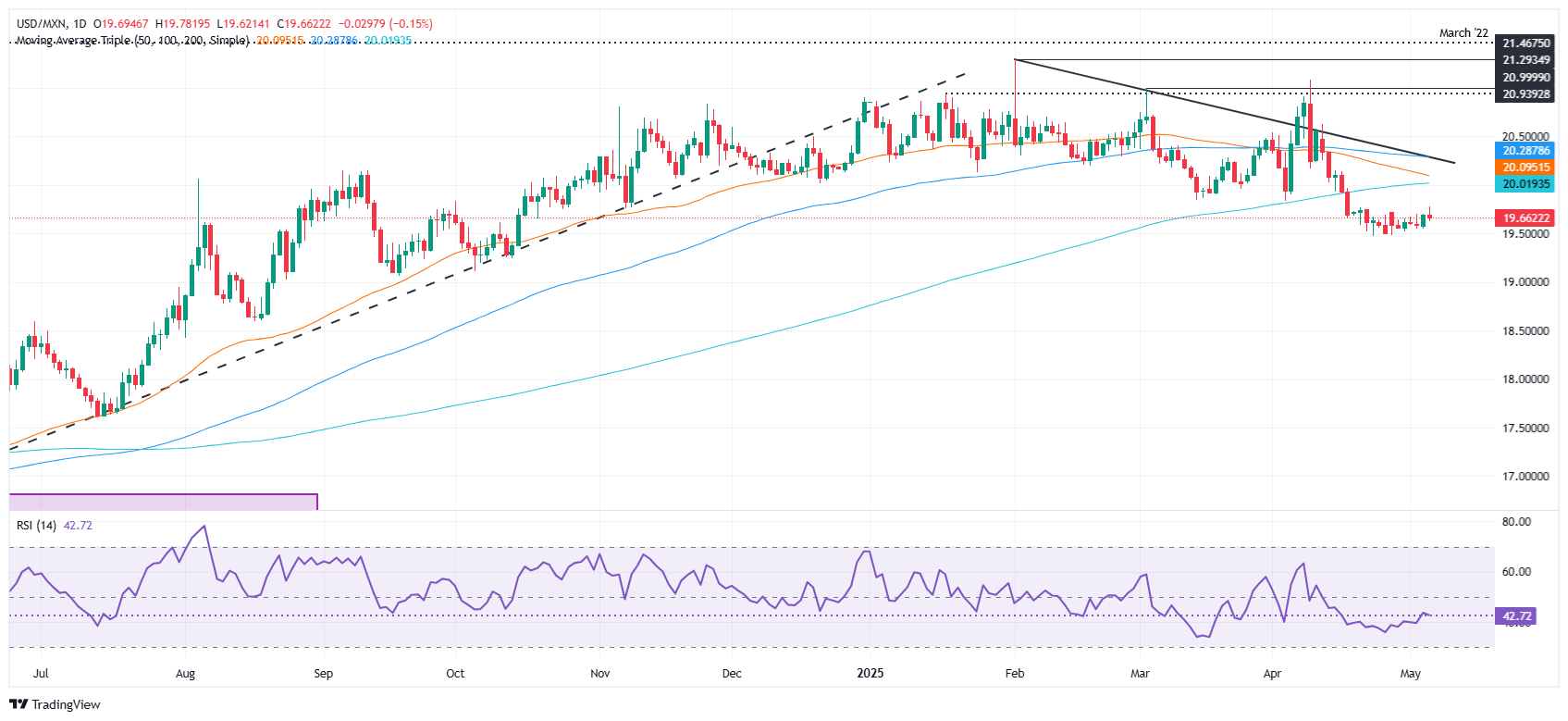Mexican Peso firms as US trade deficit widens, Trump softens tariff rhetoric
- Mexican Peso pares losses after Trump signals openness to "low and fair" tariffs and potential USMCA renegotiation.
- US trade deficit widens more than expected, pressuring the US Dollar ahead of Fed policy decision.
- Traders eye Mexico’s CPI release on May 8 for clues on Banxico’s next rate move.
The Mexican Peso recovered some ground on Tuesday against the Greenback as traders digested the latest Trade Balance figures of the United States (US), which showed the trade deficit widened. A scarce economic docket in Mexico keeps traders awaiting the release of inflation figures and Wednesday’s US Federal Open Market Committee (FOMC) monetary policy meeting. At the time of writing, the USD/MXN trades at $19.67, down 0.08%.
Risk appetite remains depressed ahead of the FOMC meeting. US trade policies continued to grab the headlines as US President Trump said he is open to imposing low and fair tariffs on partners seeking to avoid higher duties. He added, “It’s going to be a very fair number, it’ll be a low number. We’re not looking to hurt countries.”
Trump added that he’s willing to begin discussions to renegotiate the USMCA free trade agreement at a reunion with Canada’s Prime Minister Mark Carney.
The Mexican Peso rallied on Trump’s comments, with the USD/MXN paring earlier gains and turning negative on the day. Meanwhile, traders await the release of Mexico’s Consumer Price Index (CPI) report on May 8. This follows a slight increase in April’s mid-month inflation report, which showed a jump in prices, though it remained within Banco de Mexico's (Banxico) 3% plus or minus 1% inflation goal.
The US Balance of Trade revealed the US deficit widened more than expected, according to the US Department of Commerce.
Daily digest market movers: Mexican Peso modestly appreciates ahead of Fed’s meeting
- USD/MXN traders are awaiting the upcoming Federal Reserve decision. If the Fed holds rates unchanged, the interest rate differential will remain unchanged. However, if Mexico’s inflation edges lower, according to May 8 data, expectations that Banxico would reduce borrowing costs by 50 basis points (bps) on May 15 would increase.
- Citi Mexico Expectations Survey shows that most analysts estimate Banxico to cut rates by 50 bps.
- The US Commerce Department revealed that the Balance of Trade was $-140 billion higher than expected, at $-137 billion, and exceeded February’s $-123.2 billion print.
- Even though Mexico’s latest Gross Domestic Product (GDP) figures surprised the markets, with the economy dodging a technical recession, tariffs imposed on Mexican products, a reduced budget, and geopolitical uncertainties will continue to stress the country’s finances and influence the Peso.
USD/MXN technical outlook: Mexican Peso remains bullish as USD/MXN stays below 200-day SMA
From a technical perspective, the USD/MXN remains downwardly biased. Recently, the exotic pair failed to clear the 20-day Simple Moving Average (SMA) at 19.78, an indication that sellers are in charge in the near term. Buyers' momentum seems to be fading, as depicted by the Relative Strength Index (RSI), indicating that consolidation lies ahead.
If USD/MXN clears the current year-to-date (YTD) low of 19.43, this could pave the path toward the psychological 19.00 figure. On further weakness, the next floor would be the June 28 high-turned-support at 18.59.
Conversely, if USD/MXN climbs past 19.78, expect a test of the 200-day SMA at 19.98. A breach of the latter will expose the 20.00 mark.

Mexican Peso FAQs
The Mexican Peso (MXN) is the most traded currency among its Latin American peers. Its value is broadly determined by the performance of the Mexican economy, the country’s central bank’s policy, the amount of foreign investment in the country and even the levels of remittances sent by Mexicans who live abroad, particularly in the United States. Geopolitical trends can also move MXN: for example, the process of nearshoring – or the decision by some firms to relocate manufacturing capacity and supply chains closer to their home countries – is also seen as a catalyst for the Mexican currency as the country is considered a key manufacturing hub in the American continent. Another catalyst for MXN is Oil prices as Mexico is a key exporter of the commodity.
The main objective of Mexico’s central bank, also known as Banxico, is to maintain inflation at low and stable levels (at or close to its target of 3%, the midpoint in a tolerance band of between 2% and 4%). To this end, the bank sets an appropriate level of interest rates. When inflation is too high, Banxico will attempt to tame it by raising interest rates, making it more expensive for households and businesses to borrow money, thus cooling demand and the overall economy. Higher interest rates are generally positive for the Mexican Peso (MXN) as they lead to higher yields, making the country a more attractive place for investors. On the contrary, lower interest rates tend to weaken MXN.
Macroeconomic data releases are key to assess the state of the economy and can have an impact on the Mexican Peso (MXN) valuation. A strong Mexican economy, based on high economic growth, low unemployment and high confidence is good for MXN. Not only does it attract more foreign investment but it may encourage the Bank of Mexico (Banxico) to increase interest rates, particularly if this strength comes together with elevated inflation. However, if economic data is weak, MXN is likely to depreciate.
As an emerging-market currency, the Mexican Peso (MXN) tends to strive during risk-on periods, or when investors perceive that broader market risks are low and thus are eager to engage with investments that carry a higher risk. Conversely, MXN tends to weaken at times of market turbulence or economic uncertainty as investors tend to sell higher-risk assets and flee to the more-stable safe havens.

